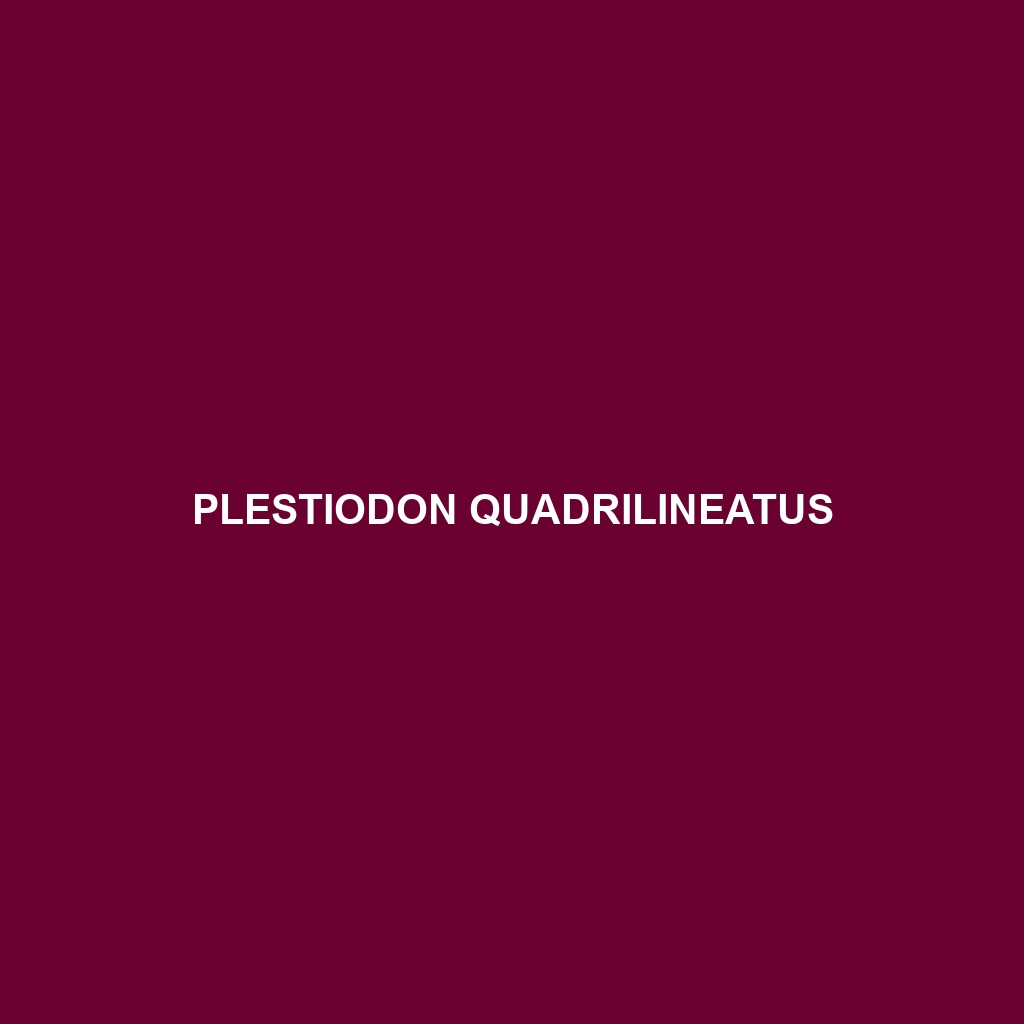Common Name
Plestiodon quadrilineatus
Scientific Name
Plestiodon quadrilineatus
Habitat
Plestiodon quadrilineatus, commonly known as the four-lined skink, is primarily found in diverse habitats across the southeastern United States. This species thrives in environments such as temperate forests, savannas, and grasslands, which provide abundant cover for basking and hiding from predators. The four-lined skink favors moist areas where leaf litter and logs create a suitable microhabitat for foraging and breeding. Geographically, its distribution ranges from the foothills of the Appalachian Mountains to coastal plains, adapting to varying climatic conditions that can include humid subtropical climates or drier regions. Its ability to thrive in a range of habitats allows it to play an essential role in the ecosystems it inhabits.
Physical Characteristics
The Plestiodon quadrilineatus is a medium-sized lizard, averaging between 5 to 8 inches in length. Its distinct physical characteristics include a slender body, a long tail, and smooth, shiny scales. The most prominent feature of this species is its four striking longitudinal stripes that run from its head to the base of the tail, providing a remarkable visual identity that aids in camouflage among the leaf litter. The coloration varies from light brown to olive green, with the stripes often being lighter or darker depending on the individual. Adult four-lined skinks exhibit sexual dimorphism; males tend to be more vibrantly colored during the mating season, showcasing brighter stripes that attract potential mates.
Behavior
Plestiodon quadrilineatus exhibits fascinating behaviors, including a predominately diurnal activity pattern, where it forages and basks in the sunlight during daytime. They are typically solitary, although individuals may be seen basking together on sunny rocks or logs. During the breeding season, males engage in elaborate courtship displays, which can include push-ups and colorful displays of their bright stripes to attract females. They are known for their remarkable ability to flee from threats; when captured, they can drop their tails as a distraction, which regenerates over time. Additionally, these lizards are known to exhibit some level of social interaction, primarily under specific environmental conditions.
Diet
Plestiodon quadrilineatus is classified as an insectivore, predominantly feeding on various small invertebrates. Its diet mainly consists of insects such as ants, beetles, and caterpillars, along with arachnids and slugs. These skinks have a foraging strategy that involves extensive searching under leaf litter, logs, and other natural debris where their prey is frequently found. Their agile movements and keen eyesight allow them to efficiently hunt and consume their food, playing a vital role in controlling insect populations within their ecosystems.
Reproduction
The reproductive cycle of Plestiodon quadrilineatus occurs during the warmer months, typically from late spring to early summer. Mating usually involves elaborate courtship rituals, where males display their vibrant colors and engage in physical displays to attract females. Following copulation, females lay eggs in concealed nests located under rocks or in burrows; the average clutch size ranges from 3 to 10 eggs. The incubation period lasts approximately 4 to 8 weeks, after which the hatchlings emerge, being independent from birth. Parental care is limited, as the female does not guard the eggs or the young post-hatching. Hatchlings are initially smaller versions of adults, exhibiting similar coloration but with less defined stripes.
Conservation Status
The conservation status of Plestiodon quadrilineatus is currently classified as least concern by the International Union for Conservation of Nature (IUCN). Despite this favorable status, habitat destruction due to urbanization and agricultural development poses significant threats to their populations. Conservation efforts focus on habitat protection and restoration to ensure sustainable populations. Ongoing monitoring is also critical to anticipate any changes in their conservation status as environmental conditions evolve.
Interesting Facts
One of the most intriguing aspects of Plestiodon quadrilineatus is its remarkable ability to regenerate lost tails, which serves as both a defense mechanism and a survival strategy. The new tail is typically different in appearance, often less colorful and with a cartilaginous structure instead of bone. Additionally, the four-lined skink has been observed engaging in community behaviors where small groups share basking spots, a behavior that challenges the notion of their strictly solitary nature. Furthermore, they play a role in local folklore among certain Native American cultures, where their unique appearance has inspired various tales.
Role in Ecosystem
Plestiodon quadrilineatus occupies a critical ecological role as both a predator and prey within its habitat. As an insectivore, it helps regulate insect populations, contributing to the overall health of the ecosystem. Their presence as prey also supports various bird species and larger mammals, thus maintaining the food web dynamics. In addition, their burrowing behaviors contribute to soil aeration, enhancing the growth of vegetation and promoting biodiversity within their ecosystems.
